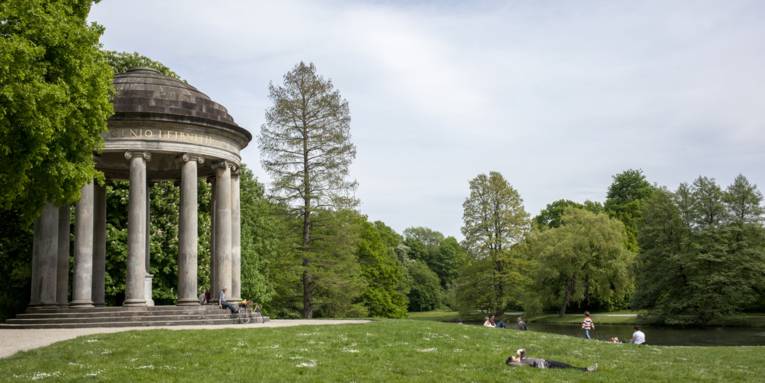The Leibniz Temple in Georgengarten was created as a pavilion with twelve ionic columns between 1787 and 1790 in honour of the Hannoverian universal scholar Gottfried Wilhelm Leibniz. It was the first monument ever to honour a person of non-noble descent in Germany. Originally the round temple building, created by royal court master builder Johann Daniel Ramberg, stood on Waterlooplatz. In 1935, it was moved to Georgengarten.
A replica of the Leibniz bust flaunts in the middle of the temple. At the back side of the socket it says on a bronze plate (in German):
Gottfried Wilhelm Leibniz (1646 – 1716)
Portraitbüste von Christopher Hewetson (1739-1799)
Original im Hist. Museum Schloss Herrenhausen
Die Anfertigung der Kopie wurde möglich durch
Die Freunde der Herrenhäuser Gärten e.V.
Mit Unterstützung der Sparkasse Hannover
und der Freunde des Historischen Museums e.V.
The Leibniz monument, at least that's what the impressive temple is also called in Hannover, is located on a small peninsular, linked by two narrow arched bridges and picturesquely surrounded by a pond. The pavilion site on a little ridge in the middle of nature is a popular photo motif and a well-liked meeting point for excursionists with a picnic basket and couples in love as well as a concert stage for amateur musicians.
 Deutsch
Deutsch
 English
English
 中文
中文
 Danish
Danish
 Eesti
Eesti
 Español
Español
 Suomi
Suomi
 Français
Français
 Italiano
Italiano
 日本語
日本語
 한국
한국
 Nederlands
Nederlands
 Norge
Norge
 Polski
Polski
 Portugues
Portugues
 Русский
Русский
 Svenska
Svenska
 Türkçe
Türkçe
 العربية
العربية
 Romanesc
Romanesc
 български
български
 © LHH/China Hopson
© LHH/China Hopson